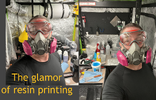Egothrasher
New Member
Good day ladies and gentlemen,
I've decided to start my journey and travel down the rabbit hole of costumes and 3d printing. I've just read through the printer post with everyone's printers. I had a few questions and would love some feedback/tips/suggestions. My project I have in mind is the master chief armor.
- Quite a few brands seem to stand out, creality and some others to name a few. Are they any recommendations in terms of printers with larger print beds, less glue up and piecing together. Ability to print pieces in one go.
-Resins printers have the ability to print smooth and more detail. So it seems there is less post cleanup required. I know they are more expensive, and I'm sure there are other factors involved. Cleanup, UV, waste disposable, it seems etc. Are they suggested for a costume piece or just stick to filament.
- Is there a big difference between the printers with an open bed versus the inclosed ones? Or should I just be looking at bed size.
- If I were to start with galactic armory files. How easy is it to scale/adjust pieces to my size. Is it just a matter of dragging them bigger or should I start to learn a new software program? I don't know if it's possible to make a mannequin in software then I can adjust the pieces and visually see them digitally before printing. Or do I need to just print and trial and error?
Thanks for all your help and can't wait to start my journey!
I've decided to start my journey and travel down the rabbit hole of costumes and 3d printing. I've just read through the printer post with everyone's printers. I had a few questions and would love some feedback/tips/suggestions. My project I have in mind is the master chief armor.
- Quite a few brands seem to stand out, creality and some others to name a few. Are they any recommendations in terms of printers with larger print beds, less glue up and piecing together. Ability to print pieces in one go.
-Resins printers have the ability to print smooth and more detail. So it seems there is less post cleanup required. I know they are more expensive, and I'm sure there are other factors involved. Cleanup, UV, waste disposable, it seems etc. Are they suggested for a costume piece or just stick to filament.
- Is there a big difference between the printers with an open bed versus the inclosed ones? Or should I just be looking at bed size.
- If I were to start with galactic armory files. How easy is it to scale/adjust pieces to my size. Is it just a matter of dragging them bigger or should I start to learn a new software program? I don't know if it's possible to make a mannequin in software then I can adjust the pieces and visually see them digitally before printing. Or do I need to just print and trial and error?
Thanks for all your help and can't wait to start my journey!



